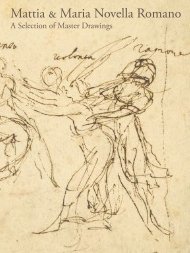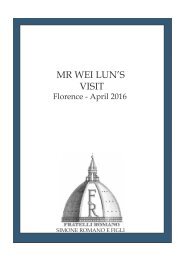A Selection of master drawings 2014
- No tags were found...
Create successful ePaper yourself
Turn your PDF publications into a flip-book with our unique Google optimized e-Paper software.
17. Umberto Brunelleschi<br />
Montemurlo 1879 - 1949 Paris<br />
Set Design: Les Indiens<br />
Tempera, pencil on card and purpurin<br />
249 x 325 mm. (9 ¾ x 12 ¾ in.)<br />
Inscriptions<br />
bottom left corner, in pencil, II° Decor – Les Indiens<br />
Set Design: Washington<br />
Tempera, pencil on card and purpurin<br />
249 x 325 mm. (9 ¾ x 12 ¾ in.)<br />
Inscriptions<br />
bottom left corner, in pencil, III° Decor – Washington<br />
Umberto Brunelleschi, born in Montemurlo, Italy, in 1879,<br />
studied painting and sculpture at the Florence Accademia<br />
di Belle Arti. He moved to Paris in 1901. At the time the<br />
French capital was swimming with advertising posters - an<br />
art form that had found a new lease <strong>of</strong> life with the advent<br />
<strong>of</strong> colour printing and the Japanese knowledge <strong>of</strong> printing.<br />
Humorous fliers also abounded, amongst which “Le Rire”<br />
particularly stood out; a long-standing collaboration with<br />
Toulouse-Lautrec made this periodical the most famous <strong>of</strong><br />
its kind. Brunelleschi immediately became a contributor to<br />
this publication, using the pseudonym Aroun-al-Rascid. He<br />
used the same name to sign his illustrations for ‘L’Assiette au<br />
Beurre’. 1 He also contributed to exhibitions including the<br />
Salon d’Automne and the Salon des Indépendants. 2 He quickly<br />
gained a prestigious position in the Parisian art world and<br />
his studio on Rue Boissonade became a meeting place<br />
for friends and colleagues, including: Kees Van Dongen,<br />
Giovanni Boldini, Amedeo Modigliani, Pablo Picasso,<br />
André Derain, and Chaïm Soutine. In 1912, he made his<br />
1. Set Design: Washington.<br />
debut as a set designer, working for a variety show at the<br />
Théâtre des Bouffes-Parisiens, appointed by the renowned<br />
leader <strong>of</strong> the company at the time, Madame Rasimi.<br />
They worked together again two years later on Y’a d’jolies<br />
femmes. The show contained a total <strong>of</strong> 17 works, but it was<br />
Brunelleschi’s <strong>of</strong> Venetian masks that enjoyed the greatest<br />
success. It was so well received that the critic <strong>of</strong> the the<br />
“Petit Parisien” wrote: «The Comédie italienne, based on the<br />
designs <strong>of</strong> the painter Brunelleschi, is without doubt the<br />
most beautiful and bold production the theatre has put on<br />
since the famous Bakst designs». 3 Following a brief period<br />
where he had to return to Italy to fight in the First World<br />
War, Brunelleschi settled permanently in Paris in 1919,<br />
where he once more worked as an illustrator for French and<br />
foreign publications. 4 He also founded “La Guirlande” in<br />
1919, with Jean Hermanovits, <strong>of</strong> which he was the artistic<br />
director. It was a luxury publication, typical <strong>of</strong> the time,<br />
entirely illustrated with colour pochoir plates, making use<br />
<strong>of</strong> Jean Saudé’s work. 5 Brunelleschi also maintained his<br />
relations with Italy by participating in the Venice Biennale 6<br />
and designing the sets for operas such as Giacomo Puccini’s<br />
Turandot (1926) 7 and Georges Bizet’s Les pêcheurs de perles<br />
(1938), both <strong>of</strong> which were performed at La Scala in Milan.<br />
In Paris, he oversaw the set design and scenery for the Casino,<br />
the Mogador, the Châtelet, the Marigny and the Théâtre de<br />
Paris. He also enjoyed great success in the world <strong>of</strong> theatre in<br />
the United States where, in 1928, the ballet dancer Leonide<br />
Massine appointed him to design four new ballets for the<br />
Roxy Theatre in New York, for which Brunelleschi was also<br />
in charge <strong>of</strong> the stage direction. He was commissioned to<br />
design the stage costumes for Josephine Baker - the famous<br />
Black Venus - for her variety shows at the Folies-Bergère<br />
(1931) and the Marigny (1934) which were wildly popular<br />
with Parisian audiences. Brunelleschi constantly developed





